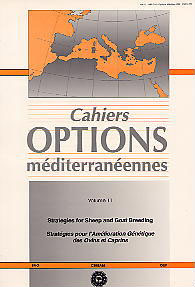| Article précédent | p. 143-154 | Article suivant |
Dairy goat breeding systems in the South of Spain
Goat population in Spain is around 3.6 million concentred in the South, mainly in Andalucía which is the first producer of goat milk (189 million of litres in 1992) used for cheese production. Two breeds account for 60 per cent of milk production. They are the Murciano-granadina and the Malagueña breeds. Their prolificacy is around 1.9 and they have an average milk yield of 500 kg per doe and lactation, with 5 per cent of fat and 3 per cent of protein. Goats are always associated with poor quality land, with difficult access and low fertility. A typical farm will have 40 to 80 does and an area of 40 to 70 ha. The kiddings are in autumn-winter in most of the cases. The common feeding system is grazing through the day and housing at night where a supplementation with concentrate is given. The selection program has started in 1993 and it is based in milk yield but it will change soon to protein yield and content.
- [ Afficher ]
- [ Télécharger ]
- [ Exporter la citation ]
Vous pouvez télécharger la citation au format :
- [ Imprimer ]
-
Mots-clés
AMELIORATION DES ANIMAUX, CAPRIN, ESPAGNE, FROMAGE DE CHEVRECiter cet article
Analla M., Muñoz-Serrano A., Serradilla J.M. Dairy goat breeding systems in the South of Spain. In : Gabiña D. (ed.). Strategies for sheep and goat breeding . Zaragoza : CIHEAM, 1995. p. 143-154. (Cahiers Options Méditerranéennes; n. 11). Meeting of the joint FAO/CIHEAM Network on Sheep and Goats, Subnetwork on Animal Resources, 1995/03/26-28, Sidi-Thabet (Tunisia). http://om.ciheam.org/om/pdf/c11/96605551.pdf



